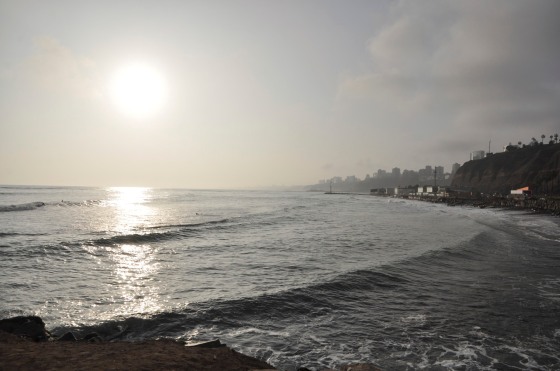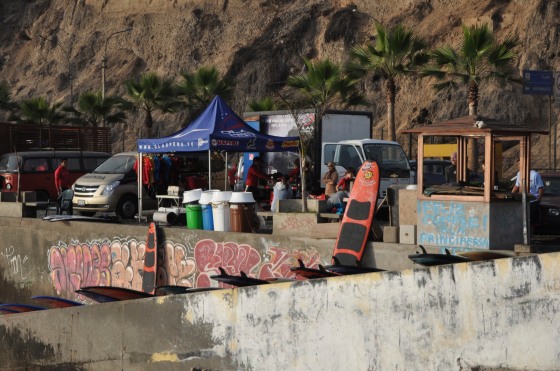Company: Etnia Peru
Cost: 85 soles
Class: 1.5 hours
Where: Barranco
When: 16:30
The reason I spend three days in Lima rather than two, apart from Manolo’s delectable churros, is to surf with my sister’s friend’s friend, Manuel. He owns a surf school called Etnia Peru and I consider signing up for an hour-and-a-half class. The plan is to surf as the sun dies and then hop in a taxi to the Oltursa terminal and take the overnight bus to Huaraz. The class is expensive, 85 soles, but Manuel assures me that it’s much more expensive in England. I don’t doubt this, since everything is more expensive is England. He also describes the surf as ‘buenazo’, which is a persuasive word.
Before buying the class I mull over whether I should do it: I’d have to spend an extra day in a city I don’t particularly like; I’d potentially make the 9 blisters I have from the Salkantay trek even worse; I’d have to spend a lot of money on something in which I’m not particularly interested. After spending hours researching blisters and sea water and surfing on the internet I conclude that the evidence is inconclusive – maybe my feet will get worse; maybe not. I then think: “Why wouldn’t you want to go surfing in Lima?”, and presently call Manuel and sign up.
He takes me and my friend Tim, who I bump into in the pharmacy, out for lunch. The place is a small restaurant full of local people on Piura and Arica. It serves, amongst other things, ceviche, which is only good until lunch because the fish has to be fresh; so if you go to a restaurant and it’s serving ceviche for dinner you should be suspicious. Manuel told me that it is really a starter, although its popularity is such that in the more touristy restaurants it has become the main event. Tim and I order the ceviche, and camarones (breaded shrimp / scampi) for the main course. Manuel orders the ‘usual’, which also involves fish cooked in lemon, but is without red onions and is accompanied by a reddish sauce.
The sun is lowering when I arrive at the Etnia office the next day. Aron, who will be my teacher, and another surfer dude arrive in a beat-up rusting red car, with Liliana – 11 years old – on her ipod in the back. We head to Barranco. There kids from Liliana’s school were taking off their wet suits. It seems that surfing is used as part of a child’s Physical Education here; I’ll soon find out why. Their teacher, a thick-set Englishman, barked instructions as they boarded the minibus. (I remembered boarding the bus after a football or rugby match and the long sleepy ride back to school, the bus smelling of stale sweat and crisps.) A different teacher stripped down, baring his hairy ginger torso, and slipped into his wetsuit.
Eventually Manuel arrived with an English girl called Sarah and a Peruvian girl – short and muscular. It had been 11 years since I’d last stood in a wetsuit, and I wondered if I’d remember anything of my last and only attempt to surf. After a short jog and some exercises I was taken to one side by Aron to be shown the three steps: arms straight; back foot up; front foot up. We practised the steps several times in the sand and Aron would push and prod and move my limbs so that I didn’t look like such a clot; surfing is supposed to be cool and so you have to look good on the board, but upon standing I couldn’t help looking like I was either wearing a tight pencil dress with my knees fused together, or like I was trying to poo over a wide hole.
The hardest part of the class was trying to get into the water and onto my board without losing my legs to the sharp battering rams of driftwood that would loiter mischievously under the incoming foam. We paddled in a wide C to avoid being hit against the rocks that form the pier. It was exhausting. Just to get to the place where you catch the waves seemed to require a superhuman effort. Previously undiscovered muscles rolling my arms around robotically and my neck wrenched back. Sometimes I’d just lie on the board and bob up and down. Aron didn’t seem to feel the strain, his body bent back like a seal, but without the blubber…. and with arms and legs.
At the point where you’re supposed to catch the wave we sat across our boards and waited. Suddenly Aron called ‘abajo’ and I’d lie on the board and point myself towards the shore. A shove from Aron and soon the board was gliding on the crest of the wave. “Arriba” he’d shout, just heard through the furore of the wave and I’d push out my arms shakily. Left foot up – slow, all slow, too slow – right foot almost, almost, then up, a crouched old man, and feeling the wave under the board. “I’m really surfing!” I tried to shout but it came out as “MMMMBLLEEER”. Why hadn’t I done this earlier? The water crashing around you, its power felt through your fragile board, the water’s every whim revealed to your legs, which flex and bend to its dance.
The second wave was the same, apart from my almost cutting off someone’s head. On the third I cried with delight, the ginger English teacher too, on the same wave, and I wanted to ride it forever. That was my last successful wave. The rest of the time was spent falling flat on my face, the water suddenly and rudely transforming into solid floor, or watching the board slip out, capsize, or any other manner of throwing me off. My early success had given me the confidence to actually start thinking about what I was doing, which resulted in me completely ballsing up all subsequent attempts. Tip for surfing: don’t think.
Manuel drives us back to the office and from there I take a taxi to the bus terminal. I smell of the sea and all my muscles, especially those recently unearthed ones, are aching terribly. I should fall asleep in seconds on the bus…
June 2013


